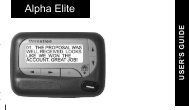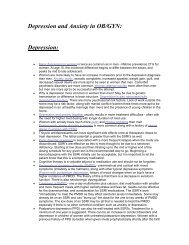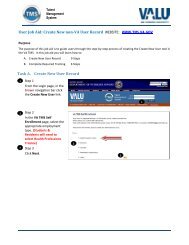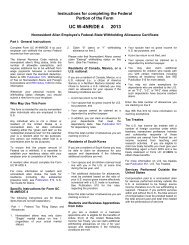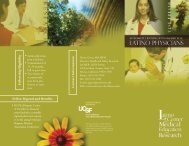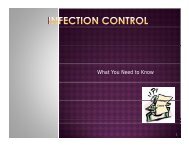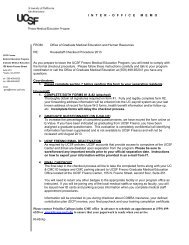A Practical Approach to Neonatal Jaundice - UCSF Fresno
A Practical Approach to Neonatal Jaundice - UCSF Fresno
A Practical Approach to Neonatal Jaundice - UCSF Fresno
Create successful ePaper yourself
Turn your PDF publications into a flip-book with our unique Google optimized e-Paper software.
<strong>Neonatal</strong> <strong>Jaundice</strong><br />
For example, Baby C is a breastfed infant delivered at 36<br />
weeks’ gestation who has a predischarge bilirubin level in<br />
the low-intermediate range. Therefore, he has two major<br />
risk fac<strong>to</strong>rs for severe hyperbilirubinemia and should be<br />
seenintheprimarycareofficewithin24hoursofhospitaldischarge.BabyD,whohasthesamepredischarge<br />
bilirubin level as Baby C, is a formula-fed infant delivered<br />
at 39 weeks’ gestation. Therefore, Baby D has no risk<br />
fac<strong>to</strong>rsandcanbeseen48hoursafterdischarge.<br />
Outpatient evaluation should include follow-up on<br />
weight,intake,voiding,ands<strong>to</strong>oling. A TSBorTcBlevel<br />
should be obtained in the outpatient setting if jaundice<br />
is increasing or if the clinical assessment is unclear as<br />
<strong>to</strong>theseverityofjaundice.Becausevisualestimationof<br />
jaundice is often inaccurate, liberal testing of TcB and<br />
TSBlevelsisasaferapproach. 2<br />
Table 3. Differential Diagnosis of <strong>Neonatal</strong><br />
Hyperbilirubinemia<br />
Hyperbilirubinemia<br />
type Hemolysis present Hemolysis absent<br />
Unconjugated<br />
Conjugated<br />
Common<br />
Blood group<br />
incompatibility: ABO,<br />
Rh fac<strong>to</strong>r, minor<br />
antigens<br />
Infection<br />
Rare<br />
Hemoglobinopathies:<br />
thalassemia<br />
Red blood cell enzyme<br />
defects: G6PD,<br />
pyruvate kinase<br />
Red blood cell membrane<br />
disorders: spherocy<strong>to</strong>sis,<br />
ovalocy<strong>to</strong>sis<br />
Common<br />
Breast milk jaundice<br />
Infant of mother with<br />
diabetes<br />
Internal hemorrhage<br />
Physiologic jaundice<br />
Polycythemia<br />
Rare<br />
Hypothyroidism<br />
Immune<br />
thrombocy<strong>to</strong>penia<br />
Mutations of glucuronyl<br />
transferase (i.e., Crigler-<br />
Najjar syndrome, Gilbert<br />
syndrome)<br />
Pyloric stenosis<br />
Common<br />
Cy<strong>to</strong>megalovirus infection, hyperalimentation<br />
cholestasis, neonatal hepatitis, sepsis, TORCH<br />
infection, urinary tract infection<br />
Rare<br />
Biliary atresia, cystic fibrosis, hepatic infarction, inborn<br />
errors of metabolism (e.g., galac<strong>to</strong>semia, tyrosinosis)<br />
G6PD = glucose-6-phosphate dehydrogenase; TORCH = <strong>to</strong>xoplasmosis, other viruses,<br />
rubella, cy<strong>to</strong>megaloviruses, herpes (simplex) viruses.<br />
Adapted with permission from Gowen CW Jr. Anemia and hyperbilirubinemia. In:<br />
Kliegman R. Nelson Essentials of Pediatrics. 5th ed. Philadelphia, Pa.: Elsevier Saunders;<br />
2006:318.<br />
HOSPITAL PROTOCOLS<br />
Allnewbornnurseriesneed<strong>to</strong>establishapro<strong>to</strong>colfor<br />
identifying and evaluating hyperbilirubinemia. Some<br />
institutions with such a pro<strong>to</strong>col report a reduced proportion<br />
of neonates with hyperbilirubinemia, its complications,<br />
and subsequent hospitalizations. 17,18 One study<br />
showed that the combined use of the AAP nomogram<br />
andapredischargerisk-fac<strong>to</strong>rassessmenthasastronger<br />
predictive value than the nomogram alone, especially in<br />
infantswithelevatedTSBlevels. 19<br />
Pro<strong>to</strong>cols should specify circumstances in which<br />
nurses can obtain bilirubin measurements. Some hospitals<br />
perform universal screening with TcB or TSB<br />
measurement on every newborn. If universal screeningisnotperformed,bilirubinmeasurementshouldbe<br />
performedoneverynewbornwithjaundiceinthefirst<br />
24 hours after birth, when jaundice appears<br />
excessive for age, and when the degree of<br />
jaundice is unclear. 2<br />
Routine discharge counseling should<br />
include an explanation of moni<strong>to</strong>ring for<br />
jaundice;thisshouldideallybeprovidedin<br />
verbal and written formats. Printer-friendly<br />
patient information handouts about infant<br />
jaundice are available in English and Spanish<br />
at http://familydoc<strong>to</strong>r.org/756.xml.<br />
Evaluation of Elevated Bilirubin Levels<br />
The differential diagnosis of neonatal hyperbilirubinemia<br />
is broad. Table 3 6 lists the<br />
mostcommoncauses;however,thepointat<br />
which intervention is recommended is based<br />
onpercentilesfortheinfant’sageinhours,<br />
regardless of the cause. Labora<strong>to</strong>ry evaluation<br />
may vary based on certain indications<br />
in the infant (Table 4 2 ).<br />
A healthy, full-term (i.e., completion of<br />
36 weeks’ gestation) infant with a mildly<br />
elevatedbilirubinleveldoesnotrequireany<br />
labora<strong>to</strong>ry studies beyond TSB measurement.<br />
An infant with physical examination<br />
findings that explain the level of jaundice<br />
(e.g.,largehema<strong>to</strong>ma)doesnotrequirefurtherwork-up,althoughtheinfantmayrequire<br />
ongoing moni<strong>to</strong>ring. Other labora<strong>to</strong>ry studiesshouldbeconsiderediftheinfantrequires<br />
pho<strong>to</strong>therapy (Figure 3 2 ) or if the TSB level is<br />
increasing rapidly. ABO incompatibility and<br />
glucose-6-phosphate dehydrogenase (G6PD)<br />
deficiencyarethemostcommoncausesof<br />
hemolytic anemia. If these conditions are<br />
May 1, 2008 Volume 77, Number 9 www.aafp.org/afp American Family Physician 1259




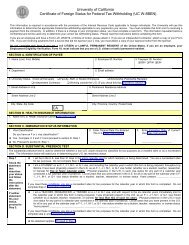
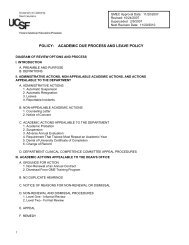
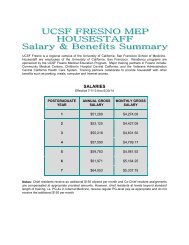
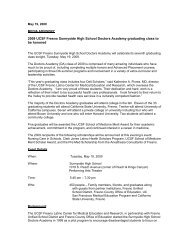
![Assistive Mobility Devices For Prevention Of Falls[1] - UCSF Fresno](https://img.yumpu.com/48127846/1/190x245/assistive-mobility-devices-for-prevention-of-falls1-ucsf-fresno.jpg?quality=85)
